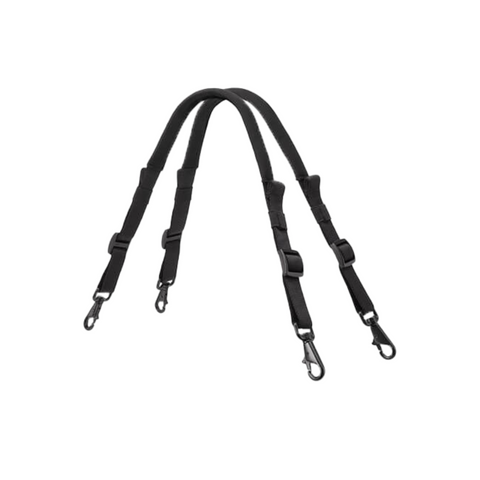If you search for “dog harnesses” in Google, more than 4 million results are displayed. There are harnesses that are nylon, cotton or leather, harnesses for small and large dogs and everything in between.
 So what’s the difference?
So what’s the difference?
The major difference lies in its functionality. There are dog walking harnesses and dog mobility harnesses. Within those two categories there are hundreds of choices.
Let’s begin by talking about the value of a harness in general.
- Safety. Large breeds or muscular dogs can easily pull you along on a leash. With a harness, you have more control. Additionally smaller dogs can choke on a collar or leash which restricts their breathing, limits their oxygen intake and makes it harder to learn. A harness takes the pressure off the neck area and disperses it across the back.
- You and your dog can get all caught up in a leash. When a dog gets excited, he may not realize he is hurting you as the leash winds around your fingers, arm or wrist. A dog harness makes it less likely that you will get wrapped up and potentially injure you or your dog.
- Although some dogs walk obediently by their owner’s side, others are harder to train. A harness makes it easier to restrict the dog from pulling you along. It also gives you two points of connection, reducing any unpleasant pressure on the dog, making him more relaxed and responsive to learning. Think of the front connect ion as the “steering” and the back connection as the “break”.
- Some dogs are Houdinis and will work to get out of their collar or break a leash. If they wander off, their pet identification is often attached to the collar.
Now we can discuss the two major functions of dog harnesses.
Dog Walking Harnesses
Are you trying to get your dog to walk by your side obediently?
Too often, I have seen dogs walk their owners versus the owner walking the dog. We’ve all seen it … dogs that are literally pulling their humans to hurry along. Or dogs that dart off to the side or as far as their leash will allow them to wander. If you want to train your dog to walk by your side, you should probably invest in a dog walking harness. These are also known as “no pull” harnesses, meaning that the dog does not pull you along.
The types of dog walking harnesses that are most popular include:
- Front clip harnesses – Front-clip harnesses have the leash attachment in the center of the dog’s sternum and are more effective in reducing pulling.
- Back clip or step-in harnesses – On the back-clip harness, the ring that the leash clips onto is located on the top of the dog’s back. These harnesses are for calm dogs already trained not to pull on the leash, as the design will not discourage pulling.
- Tightening harness – These harnesses tighten and add pressure if the dog begins to pull. If you use a tightening harness, make sure it is a gentle, non-pain-inducing pressure.
- Vest harnesses – With a vest harness, the D-ring for the leash is on the dog’s back, far away from the dog’s vulnerable throat. A vest harness is not designed for leash training or dogs that are not well behaved on a leash. There is a vest harness for service dogs, and others that are used for fashion and warmth. They can close in back or front.
Dog Mobility Harnesses
Do you have a dog that is arthritic, aging, injured or recovering from an illness or surgery?
Like the name implies, mobility harnesses or support harnesses as they are often called, are for dogs that need help getting around and “a lift up”. For instance, many senior dogs find it hard to get in and out of a car. If you try and lift them, either you or they could be hurt. A mobility harness lifts the dog’s mass from below (beneath the chest and pelvis), distributing the weight more evenly over large padded surfaces.
With hip dysplasia, myelopathy, joint disease and muscle atrophy affecting older dogs, these harnesses become a real help for owners and vets who need it. And unlike other dog harnesses, mobility harnesses can stay on your dog for extended periods of time.
Many mobility harnesses come with walking accessories, such as handles or leashes to make walking even easier.
The key to ANY dog harness is the fit so that it is comfortable and safe for the dog. Most harnesses come in sizes from extra small to extra, extra large, so you should be able to find one that fits your dog’s size and purpose.



